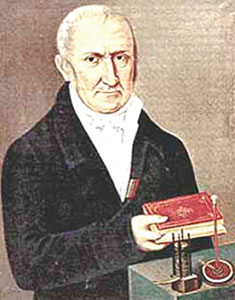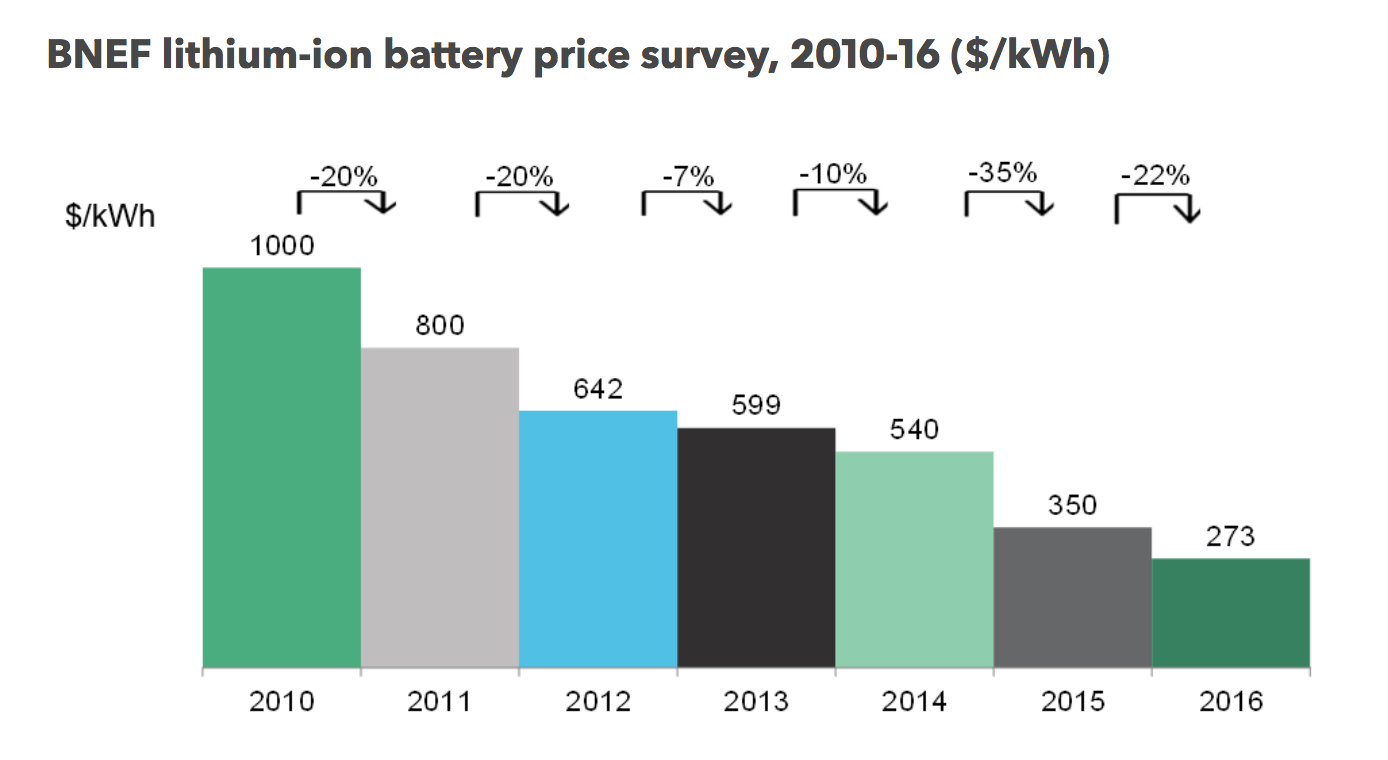Economical energy storage has long been the Holy Grail of electricity. Since 1800, when Alessandro Volta invented the electric pile (a forerunner of the modern battery), hobbyists, scientists, and engineers have experimented with chemicals and materials to create economical storage at a smaller scale than a hydroelectric dam and with a more portable technology than, say, compressed air or a flywheel.

Alessandro Volta, 1800 (American Physical Society)
Battery storage is expensive compared to generation and grid distribution, especially at small scales. Table 2 below (source: Battery University) provides a salient reference point for consumers thinking about the economics of battery storage. Electricity from the AA battery we use in electronics costs $175 per kilowatt hour, in comparison to the roughly $0.20 (that’s 20 cents) per kilowatt hour for generated electricity purchased using the distribution grid. The smaller AAA battery storage costs $580 per kilowatt hour, over three times the cost of the AA battery storage.

Smaller means more expensive, so imagine the even higher equivalent cost of stored energy from a watch, hearing aid, or bicycle power meter battery. We use these small primary batteries for low-energy, portable applications, so we are willing to pay the high energy cost to acquire the other attributes of the battery (mostly portability). Most primary batteries for electronics are much more expensive than the AA battery.
Vehicle batteries are considered secondary batteries. With renewed interest in producing electric vehicles over the past decade, battery research has accelerated and broadened to cover a range of different approaches and materials. In fact, I characterize Tesla as a battery company, not a car company — the car is the application, but the technology and the research at the core of the business is the battery. Research and commercialization of the lithium ion vehicle battery from Tesla and others to reduce costs and increase vehicle range is yielding new insights, increased energy efficiency, and as a result more economical energy storage. Bloomberg New Energy Finance reported in December 2017 on a survey of 51 battery companies:
Lithium-ion battery packs are selling at an average price of $209 a kilowatt-hour, down 24 percent from a year ago and about a fifth of what it was in 2010, a Bloomberg New Energy Finance survey shows. The rate has further to fall — reaching below $100 a kilowatt-hour by 2025, according to a report by BNEF analyst James Frith.

(Graphic source: Cleantechnica)
Battery technology improvements aren’t happening in isolation. “How cool is this?” item 1: storing energy in batteries means the batteries need to be charged, and ideally charged at a time when the marginal cost of generation and distribution is very low (in other words, in the middle of the night). Transactive technologies and regulatory frameworks that allow dynamic pricing (whether vertically integrated or competitive) enable EV owners to automate the charging process. One concern that has arisen, though, is the potential for EV charging demand to exceed distribution system capacity to meet that demand. A transactive energy system with dynamic pricing avoids that, treating the distribution system capacity constraint as a constraint, which would be reflected in the prices that would emerge in the retail market. We’re not there yet, but small steps in some places are moving in that direction.
Recently UPS increased its fleet of electric delivery vehicles in London from 65 to 170, and did so without the local distribution company having to increase grid capacity to enable them to charge all of them for daily use.
UPS thinks this is a world first, right in the heart of a mega-city. We are using new technology to work around some big obstacles to electric vehicle deployment, heralding a new generation of sustainable urban delivery services both here in London and in other major cities around the world. … We are applying new technology to make the charging process smarter and our delivery service cleaner.
The Inside EVs article does not provide technical details, but it sounds like UPS has installed large-scale batteries at their main warehouse facility, will charge them when the electricity price is low, and use them in conjunction with grid power to charge the vehicles. I’d like to know what kind of electricity contract they have for the whole facility — dynamic pricing, etc. — to better understand how they can use automation to enable them to access cheaper (and lower emission) energy to charge their growing EV fleet.
“How cool is this?” item 2: EVs are a more attractive alternative in locations where the temperature doesn’t go below freezing, because lithium ion batteries typically drain when it’s below freezing or can’t be charged at lower temperatures, shortening the range of the vehicle and reducing the time that it’s available for use. Researchers at Penn State have developed a new battery that is self-heating and can automatically switch to perform a fast charge:
The self-heating battery uses a thin nickel foil with one end attached to the negative terminal and the other extending outside the cell to create a third terminal. A temperature sensor attached to a switch causes electrons to flow through the nickel foil to complete the circuit when the temperature is below room temperature. This rapidly heats up the nickel foil through resistance heating and warms the inside of the battery. Once the battery’s internal temperature is above room temperature, the switch turns opens and the electric current flows into the battery to rapidly charge it.
The battery cell itself can switch from self-heating to rapid charging automatically. This type of battery could reduce range anxiety and make EVs more attractive in more types of climates.
This portfolio of innovation — better lithium ion batteries, different types of batteries with different chemicals and materials, and smart grid transactive technologies to automate charging in response to economic signals — shows how technological change happens. It happens in complementary innovations. It happens in ecosystems of technologies and people, not in isolation. It happens as recombinant innovation, taking existing technologies and approaches, often from other industries, and combining them in novel ways to achieve novel objectives.
I am really skeptical about battery hype:
There is little possibility of real order of magnitude improvement in batteries. Yhe voltage of any battery is fixed by the chemical reaction between anode and cathode, and the amperage is a straight line function of the quantity of reactant.
If your battery’s chemistry is Lithium and Cobalt, you have a real problem with large quantities of scarce expensive materials. There is no reason to suppose that they will become cheaper, and much reason to believe that they will become more expensive. Especially if they are being bought in boxcar lots to make utility scale batteries.
There are cheaper battery chemistries such as sodium sulfur. But, they come with lots of other problems like high temperature operation and finicky corrosive, combustible materials.
Further, battery chemistries are mature, well characterized science. In the 218 years since the battery was invented, just about every possible combination of chemicals has been tried. Don’t expect something nobody ever thought of to show up.
Bloomberg’s poll of Battery Companies also…I mean, I read less than I expected to there Battery Co. shout-out wise…manages to toy in ‘Prices are set to…by 2025,’ which all good traders should aspire to include in their speech patterns.
It’s been my indistinct pleasure to live in a different Universe from Fat Man, and although Transactive technologies…is that like a Right of Way contract fattened with nicer hours rather than an ETH Broker Fee?…sounds like a continuing great way to avoid a marginal-amp tax, and nickel thick-film heaters a technology to not avoid having (now that a plurality of batteries help run things) I am also looking forward to cheap shirt (velo) batteries made out of finicky corrosive, combustible carbon, magnesium and sulfur and charged by dance.
Still not sure I haven’t missed 1 and 2 entirely myself; markets that aren’t violently stupidly staid, and putting gentle heating on mainstream batteries that need to be 5 degrees C and above to work only sound cool and important as much as oversight against political party foreign (corruptive) influence, and as involving and interesting pols? I guess I’ll read that ‘Recombinant Innovation’ bit and try to disabuse myself that startups do not simply rot each other with cross licensing in a vat behind Myrvhold’s house until unicorns leak whole from the seams. That CA (NY, USA) sale, though! US$19B cash solution, meet US$19B cash problem…you’ve met Cronus, Rhea and Tethys, right?
I am thrilled that, without militating hard for regency, the Royal Society of Chemistry and the Royal Chemistry Society publish some applied and power (okay, FUELS) and materials journals, and RSS feeds, that put the lie to the yieldless permutation game theory. http://feeds.aps.org/rss/topics/plasmonics.xml and other IoP things too. Sometimes Angewandte Chemie at Wiley-Blackwell too, though recent free-to-read issues were all up in new antibiotics and barely any electronic functions even for the electric antibiotic fans out there.
Fat Man. Would like to talk to you re robbradley58@gmail.com. Lynn K, the UPS London move to EVs, what were the government subsidies involved, if any?